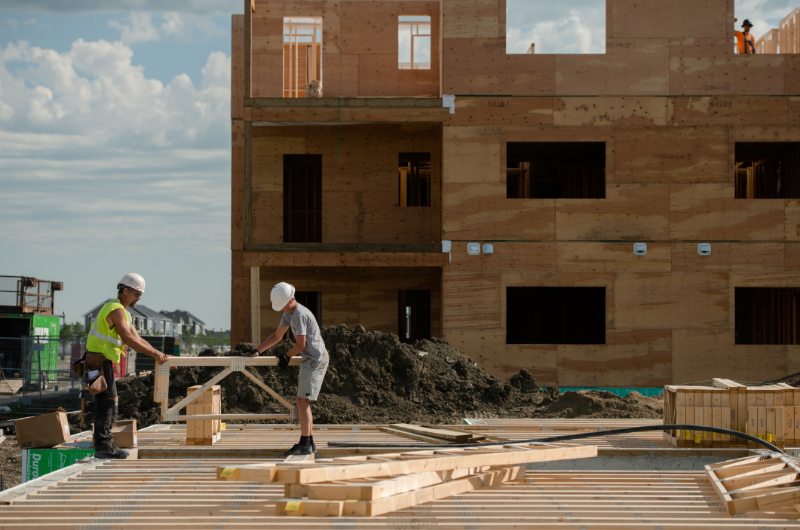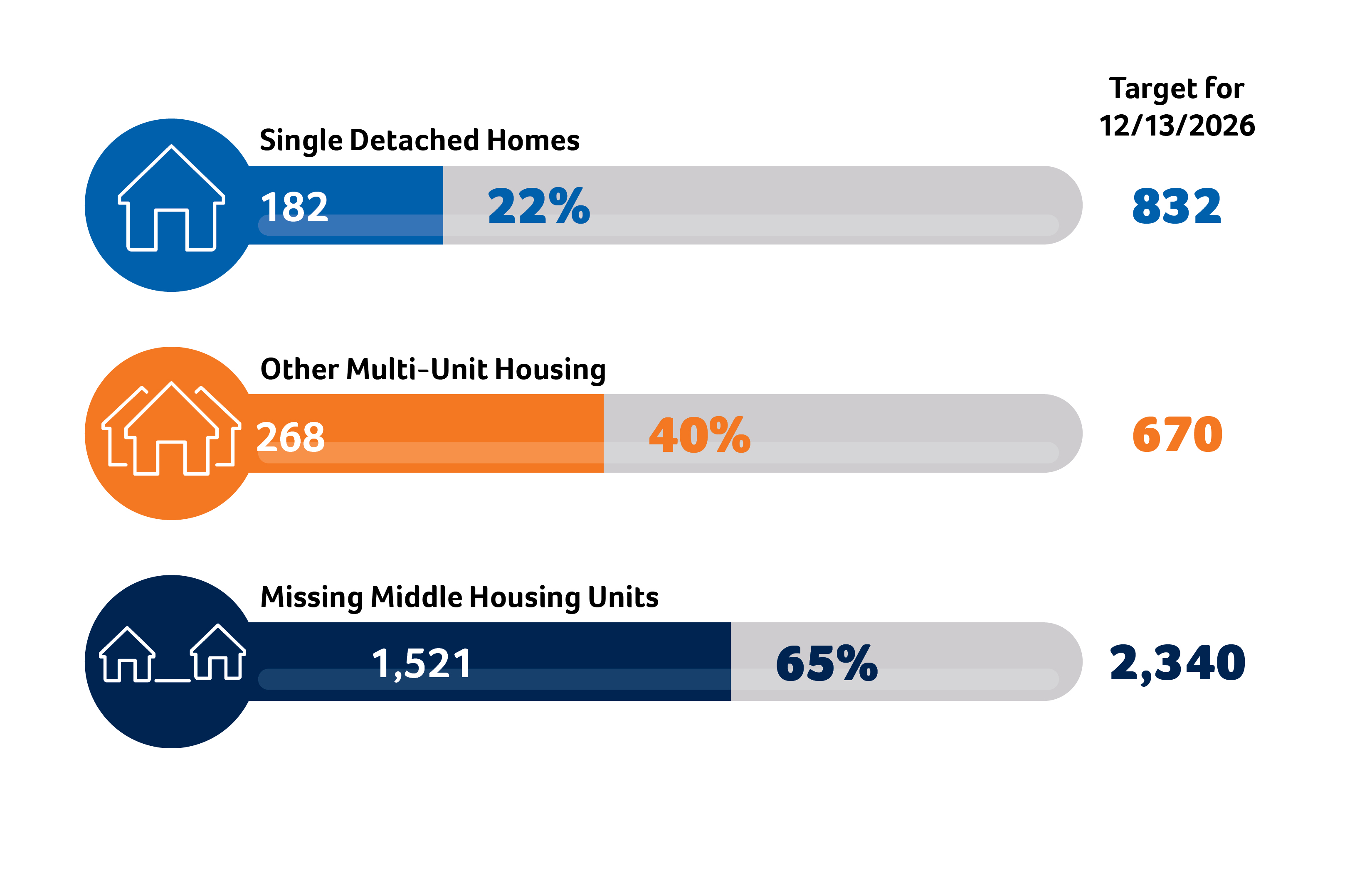 The Housing Accelerator Fund will help keep Regina affordable by supporting the development of multi-unit, missing middle, transit-oriented, and affordable housing.
The Housing Accelerator Fund will help keep Regina affordable by supporting the development of multi-unit, missing middle, transit-oriented, and affordable housing.
Introduction
The Housing Accelerator Fund (HAF) was created to address the housing crisis affecting many cities in Canada, including Regina. The lack of sufficient housing has created a situation where many residents struggle to find suitable homes. By increasing the housing supply and supporting the development of diverse housing options, the HAF helps ensure that communities can meet the varying needs of their residents, ultimately fostering sustainable urban growth.
HAF initiatives benefit everyone in the community. The fund supports municipalities committed to increasing their housing supply and housing affordability. It supports a range of stakeholders, including developers, non-profit housing providers, and community organizations by providing the necessary funding and resources to accelerate housing development for the city.
The fund supports the construction of various housing types, from affordable units to market-rate homes, ensuring that people from all economic segments can find suitable housing.
HAF Housing Target Tracker

Regina's HAF Action Plan
The City’s Action Plan outlines 11 initiatives that the City will undertake to increase housing development in the near and long term. These initiatives were developed to address some of the specific challenges we are facing. These include building type and density limitations due to zoning, infrastructure deficiencies and support for non-profit housing providers.
Below are the 11 initiatives in the Action Plan. Click each heading to reveal more information.
1. Enable high-density housing development within the City Centre.
What does this mean?
We need to remove roadblocks to high-density development, in particular restrictions on building height and eliminating parking requirements. By doing this, it will allow more building types that would create greater density within the City Centre. This means changing the existing zoning bylaws to accommodate this.
Why is it important?
This initiative will support increased housing development in the City Centre near employment opportunities, retail and commercial businesses, and community services and facilities. This will help to support City Centre neighbourhoods as complete neighbourhoods that are walkable and provide a high level of transit access.
Who does it affect?
This initiative is specifically focused on the City Centre. Please see the City Centre map located under our maps link.
2. Enable mid- and high-rise development along urban corridors & main transit routes.
What does this mean?
Within 200 metres along main transit routes, a 6-storey building could be built and within 800 metres - from a transit hub, a 4-storey building could be built. Click on the Housing Type Identification Guide link for examples of 4 and 6-storey buildings.
Why is it important?
Allowing mid and high-rise buildings along main transit routes helps lower energy use and greenhouse gas emissions. It reduces travel distances to schools, work, and community amenities, makes transit service and active transportation (like walking and biking) more practical, and uses land and infrastructure more efficiently. This aligns with the direction of the Energy and Sustainability Framework.
Who does it affect?
People who live in neighbourhoods near a main transit route or transit hub will see zoning changes for specific areas of their neighbourhood. Please refer to the map that highlights these features.
3. Advance the development of missing middle housing in central neighbourhoods.
What does this mean?
In our city’s older central neighbourhoods, zoning changes will allow for the construction of missing middle housing forms (multiplexes, low-rise apartments).
Why is it important?
The initiative will allow smaller scale, multi-unit housing to be built in central neighbourhoods that currently have a mix of land uses, services, and amenities and are served by transit. The construction of what has been referred to as missing middle housing has been identified as an effective tool in providing affordable housing options.
Who does this affect?
This initiative is specifically focused on older central neighbourhoods with more standard narrow lot sizes. Please see the map located under our maps link.
4. Support the provision of greater housing diversity in established neighbourhoods.
What does this mean?
This initiative will include adjustments to zoning in existing residential neighbourhoods to permit incremental changes that support greater housing diversity over time. This will include updating regulations in the Zoning Bylaw to allow up to four units to be built on lots within the City’s intensification boundary and up to two units to be built on lots outside the intensification boundary.
Why is it important?
This initiative will support sustainable housing provision, long-term and equitable access to housing citywide. Increasing flexibility of housing type in established neighbourhoods will also make them resilient to demographic shifts, allow residents to age in place, and ensure that neighbourhood populations can maintain school enrollment levels and support viability of walkable neighbourhood retail.
Who does it affect?
This would affect not only the current residents of a neighbourhood but also those not currently living there, such as young families who would like to start their life off in an established neighbourhood.
5. Encourage conversion of non-residential buildings to residential (e.g., office conversions).
What does this mean?
We are looking to develop a pilot program to encourage building owners and developers to convert existing office or commercial buildings into residential use.
Why is it important?
Since COVID-19, we have seen a dramatic shift in how we work. Many companies have reduced their footprint in office buildings, creating a significant amount of vacant space. Converting this unused space to residential helps to utilize existing infrastructure and keep these buildings as vital members of the community.
Who does it affect?
We see this initiative benefiting both the participating landlords with vacant surplus office space and those individuals looking for an opportunity to live closer to work.
6. Preserve and increase affordable housing in partnership with non-profit housing providers.
What does this mean?
Provide funding opportunities to non-profit housing to fix up an existing property or add to their current housing inventory.
Why is it important?
Affordable housing needs in every community are growing. Helping our city’s non-profit housing agencies repair existing properties and keep them on the market means we haven’t lost an important asset to the affordable housing inventory. Also, if we can provide a program that assists an agency in bringing additional units online, we have helped to increase the available affordable housing.
Who does it effect?
This initiative is a critical support for our non-profit housing suppliers and those searching for affordable housing.
7. Support pre-development work for housing projects, particularly affordable housing.
What does this mean?
This initiative aims to help builders and developers with some of the costs related to the predevelopment phase of a project.
Why is it important?
When assessing if a project is viable, there are often costs associated with exploring the existing condition of the land or structures. This can often be a sticking point for developing affordable housing with low margins. Developing a grant or loan program to help developers with engineering or environmental studies would take away some of the financial risks for exploring a project's feasibility.
Who does it affect?
This initiative will support non-profit housing suppliers wanting to explore the feasibility of a project but don’t have the funds for predevelopment costs.
8. Reduce Council approval for housing-related Discretionary Use applications.
What does this mean?
Discretionary use is an application type that evaluates the compatibility of a proposed land use with the surrounding area based on particular thresholds (e.g. height). The review process involves technical analysis, public notice and input with the decision to approve the application resting with either a Development Officer or City Council.
The City is updating the Zoning Bylaw to reduce the number of housing-related discretionary use applications and provide greater certainty in the building and construction process. City staff will still complete a comprehensive review of all development applications and, where rezoning is required or where the development exceeds or otherwise does not meet the permitted use criteria for the zone (e.g. height, setbacks, massing), additional analysis, consultation and approvals will still be required.
Why is it important?
Undertaking a discretionary use application can be a lengthy process, taking up to six months, with no guarantee that the application will be approved. This delay costs time and money to the developer or building owner, and increases uncertainty, which can discourage them from proceeding with their project.
Who does it affect?
This will benefit those who may need to submit a discretionary use application for a housing-related project. They will have greater certainty as to whether their proposed project can proceed in a shorter amount of time, encouraging them to submit a permit application.
9. Create a process to dispose of City-owned land to develop affordable housing.
What does this mean?
The City will create a process for selling or developing City-owned land that can be utilized for affordable housing.
Why is it important?
The City's land assets provide a unique opportunity to support the development of affordable housing. Whether it is gifted to a community land bank or a non-profit developer, it provides desperately needed land for this purpose.
Who does it affect?
Those who live around the property will benefit from the development of underutilized land. It will also benefit groups and agencies that want to develop affordable housing but cannot access land.
10. Align infrastructure planning in the City Centre and central neighbourhoods.
What does this mean?
By aligning our long-term infrastructure plans with our need for additional housing units, we can unlock lots and sites prime for residential development.
Why is it important?
Every city in North America struggles with infrastructure deficits. This means municipalities have a large demand for infrastructure upgrades and extensions. With HAF funds specifically targeted to areas where housing could be added or densified by expanding the existing infrastructure or adding additional services, we can bring many new housing units online.
Who does it affect?
Expanded or new infrastructure will ultimately benefit everyone as we lessen the demands on existing infrastructure to accommodate additional growth.
11. Update the Development Charges Model to support long-term housing growth.
What does this mean?
Our City utilizes development charges to assist with the buildout of either new developments or infill development projects. These fees help to pay for the City’s infrastructure costs for supporting the proposed development and growth.
Why is it important?
There is an important balance when it comes to development fees charges. You must ensure that you cover the city’s expenditure but don’t discourage new projects. We received feedback from industry stakeholders that the City’s current approach was not working. In response to this feedback, a Development Charges Review was undertaken to address identified concerns and issues.
Who does it effect?
This affects everyone in our city as it determines growth for the future.
Timeline
Below is a timeline of activities related to our HAF Application and Action Plan.
| 2023 | |
| March | Housing Accelerator Fund launched by the Federal Government |
| June | City Council directed Administration to submit HAF application with action plan |
| November | City Council passed motion directing Administration to amend HAF application increasing residential development permissions citywide and prepare bylaw amendments to support this change. |
|
2024 |
|
|
February |
City signs an agreement with the Federal government for $35.2 Million under the Housing Accelerator Fund. City Council approves Phase 1 of the zoning bylaw changes to support HAF Initiatives. |
|
April |
City Council approves Phase 2 of the zoning bylaw changes to support HAF Initiatives. |
|
June |
City Council approves Phase 3 of the zoning bylaw changes to support HAF Initiatives. |
|
July |
City Council approves the report updating the Development Charges Model to support HAF initiatives. |
|
September |
City Council approves amendments to Neighbourhood Plans to align with previous zoning bylaw changes and support implementation of the City's HAF initiatives. |
|
2025 |
|
|
January |
Housing Needs Assessment Report to be presented to council for approval. |
|
February |
HAF pilot programs for office conversion, pre-development grants and rent repair for non-profits to be presented to council. |
|
TBD |
Zoning Bylaw updates to enable more development opportunities and increase user experience with the document. This will continue to advance HAF Actions #1-4 and 8. |
Types of Housing
HAF supports the building and development of various types of housing. This gallery provides a visual guide to show examples of the kinds of housing we already have in our city and others that we would see more of as a result of our HAF initiatives.
The models shown are for reference only. Actual development and design may vary.
Frequently Asked Questions
Expand each question below to learn more about the Housing Accelerator Fund.
What are the requirements for participating in the Housing Accelerator Fund?
Canada Mortgage and Housing Corporation (CMHC) outlined 10 best practices for communities to consider when developing their HAF Action Plans. They are as follows:
- End exclusionary zoning.
- Make municipally owned lands available for housing.
- Increase process efficiency.
- Prioritize the development approval process for rental and affordable housing.
- Comprehensive review of development charges and fee schedules.
- Reduce or eliminate parking standards.
- Eliminate restrictions (i.e. height) to allow a greater variety in housing types.
- Develop affordable housing community improvement plans.
- Design and implement guidelines for pre-approved missing-middle plans.
- Develop grant programs to encourage the development of housing types that align with the Housing Accelerator Fund.
Applications that addressed these best practices were scored higher than those that did not.
Is the Housing Accelerator Fund just about affordable housing?
While affordable housing is part of many jurisdictions’ programs, including Regina’s, so is market housing. To address the housing crisis, we need to build many more housing types for all economic segments of our community.
Why did we apply for it?
Regina, like most other cities in North America, is facing a housing crisis. Any additional funding to help address this community crisis is welcome.
What exactly is the Housing Crisis I keep hearing about?
Simply put, we don’t have enough homes to shelter our residents. This is due to several reasons. First, we haven’t been able to build enough homes to keep up with demand. Second, we don’t have enough housing variety to meet our citizens' diverse needs.
Why did we get the amount of funding we did?
Each community worked with CMHC to develop a plan to add a specific number of units to their community. In the case of Regina, the goal is to support an additional 1,100 units of housing units above our average annual growth over the next three years (by December 2026). The funding amount is determined by the number of units in the goal. In our case, we were awarded $35,275,000.
How is our city going to spend its funds?
In our application, we were required to outline the initiatives we planned to implement to reach our goal of 1,100 additional units. Each initiative had an estimated dollar value assigned to it. We are currently examining the best way to allocate funds between the various initiatives.
Did we get all the funds at once?
Our agreement with CMHC has us receiving the funds over a four-year period. We have received our first advance of $8,818,750, which covers 2023/24. Our second advance will cover the year 2024/25, the third 2025/26 and the fourth (final) will be for 2026/27. Each installment will be for the same amount as the first.
Could we see our funding reduced at any time during that period?
If we meet the objectives outlined in our agreement within the agreed-upon timeframe, we won’t risk having our funding reduced. We are required to report back to CHMC twice a year to ensure we are staying on track.
What can we spend our HAF funds on?
Here’s a list straight from our contract with CMHC on what we can spend our HAF funds on.
- Any initiative included in the Approved Action Plan
- Investments in affordable housing including:
- Construction of affordable housing
- Repair or modernization of affordable housing
- Land or building acquisition for affordable housing
- Investments in housing-related infrastructure including:
- Drinking water infrastructure that supports housing
- Wastewater infrastructure that supports housing
- Solid waste management that supports housing
- Public transit that supports housing
- Community energy systems that support housing
- Disaster mitigation that supports housing
- Brownfield redevelopment that supports housing
- Broadband and connectivity that supports housing
- Capacity building that supports housing
- Site preparation for housing developments
- Investments in community-related infrastructure that supports housing
- Local roads and bridges that support housing
- Sidewalks, lighting, and bicycle lanes that support housing
- Firehalls that support housing
- Landscaping and green spaces that support housing
How will we be spending our HAF funds?
While there will be a small percentage of the HAF funds that will go to the development and administration of the HAF Action Plan initiatives, roughly 3%, the balance will be spread over the other eligible categories (investments in affordable housing, housing-related infrastructure, and community-related infrastructure that support housing). The exact amounts are being determined as we prepare for the 2025 budget.
Who decides where the HAF funds get spent?
While various areas of the city administration will make recommendations regarding initiatives, programs, and amounts to be spent, ultimately, the City Council has the final say. Recommendations will be made to the City Council as part of the budget process, at which time they will evaluate them as to their alignment with the HAF agreement.
Who benefits from these initiatives and programs?
Ultimately, all citizens will benefit from our City’s participation in the HAF program. More housing being built means we are able to meet the needs of our growing city. Adding more housing options to many of our existing neighbourhoods will also help ensure that local schools and businesses continue to thrive, that new families can access existing amenities and services, and that people can age in their communities.
I like my neighbourhood the way it is now. Why should I support the zoning changes that HAF is making?
Everyone has a special connection to their own neighbourhood. Especially if you are a long-time resident. But change is inevitable for all parts of our city. As our workplaces and home lives evolve, so must our neighbourhoods meet the needs of our current and future residents.
The zoning amendments being advanced through the HAF Action Plan will allow for gradual change and reinvestment in our established neighbourhoods over time. It will also support continued investment in infrastructure and public amenities and support the ability of residents to age in place and continue to enjoy their neighbourhoods.
Will adding density decrease my property value?
Based on research and statistics from across North America, there is no evidence to suggest that property values will go down with an increase in density. In fact, many neighbourhoods that have seen incremental growth have also experienced property values increase.
What is 'missing middle housing'?
Missing middle housing refers to smaller-scale multi-family housing types such as garden suites, secondary suites, duplexes, triplexes, fourplexes, row houses, and low-rise apartments up to 4 storeys. Over time, these housing options have been developed in many neighbourhoods throughout our city including most recently in new development areas such as Harbour Landing and the Greens on Gardiner. Since at least the early 1990s, the City’s zoning regulations limited the development of these housing options, particularly in established neighbourhoods. Missing middle housing provides more attainable and affordable housing options to meet the needs of new Canadians, families and seniors.
What did the city agree to by signing onto the Housing Accelerator Fund?
By signing the agreement, the city has committed to carrying out all the actions outlined in the initiatives we have proposed. This includes the delivery of 1070 net new units above our usual housing output over the next four years.
Sign Up For Email Updates
Receive updates about the City's Housing Accelerator Fund and Expanding Citywide Housing Options initiatives by email. Use the sign-up form below to subscribe. Watch for a subscription confirmation email and click the confirmation link to complete your signup. This email may be in your junk or spam folder.
Glossary of Terms
Some words and acronyms you might see used when discussing Regina’s Housing Accelerator Fund Action Plan initiatives.
| Term | Meaning |
| Discretionary Use (DU) | A use of land, building or other structure that may be permitted in a zone only at the discretion of the development officer where allowed and at a location specified by the City Council. |
| Duplex* | A building with two separate units that can be occupied by two different households. |
| Triplex* | A multi-unit building with three units that can be occupied by three different households. |
| Fourplex* | A multi-unit building with four units that can be occupied by four different households. The layout can be side-by-side or stacked on each other. Typically, they're a combination of both. |
| Main Transit Route | Transit routes that are designated to be served by a higher level of transit, including express buses with limited stops and/or operating at higher frequencies. These routes will form the basis of any future bus rapid transit services. |
| Missing Middle Housing | Missing Middle Housing refers to smaller-scale multi-family housing types such as garden suites, secondary suites, duplexes, triplexes, fourplexes, row houses, and low-rise apartments up to 4 storeys. |
| Parking Minimums | Parking minimums are requirements, as dictated by a municipality's Zoning Bylaw, for all new developments to provide a set number of off-street parking spots to cover the demand for parking generated by the development. |
| Transit-Oriented Development (TOD) | Higher-density development in proximity to transit with design qualities that encourage the use of transit, such as a high-quality pedestrian environment and a mix of uses. |
| Transit Hub | Points identified in the transit network that serve as a major city-wide destination, is a major transfer location between multiple transit routes, and/or is adjacent to mixed-use or denser areas. A transit node should provide for multi-modal connections and have the potential for transit-oriented development to serve as anchors for transit in local communities. |
| Urban Corridors | Lands along an established or new major road, urban arterial or transit corridor that have the potential to provide a focus for higher density or midrise, mixed-use development that facilitates active transportation modes. |
* These building types are called by different names in the current zoning bylaws and the OCP.































